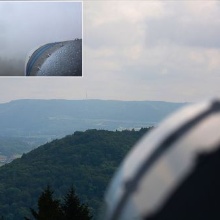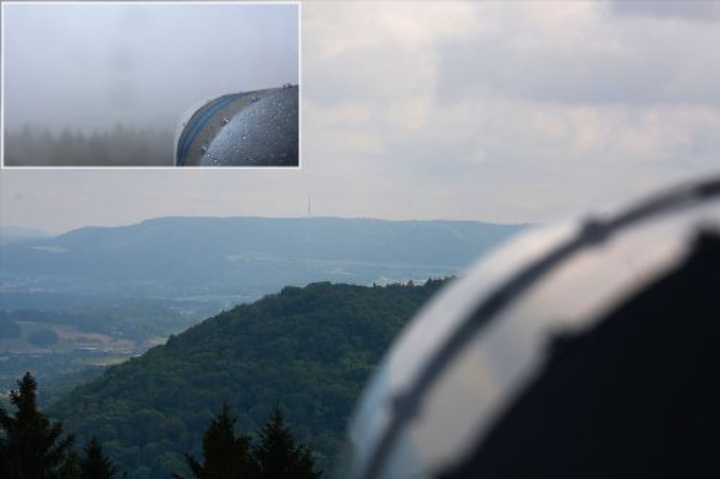Scientists from the University of Stuttgart have succeeded in transmitting a data rate of 15 gigabit per second (Gbit/s) with a microwave radio link in the so-called E-band over a distance of more than 15 kilometres. This corresponds to three times the data rate and distance compared to today’s state of the art. The transmission was even possible in fog and light rain. Such microwave radio links could be used for the next generation of satellite communication where large amounts of data have to be brought from the satellite through the earth’s atmosphere to the ground station. The same frequency range, however, is also permitted for the terrestrial data transmission and is currently experiencing a global upswing.
Ever increasing demands on the data quantities to be transmitted, driven by the unrelenting advancing development of mobile media usage behaviour require new solutions for cable-free communication with extremely high transmission speeds. Due to the high available bandwidths, frequencies in the so-called E-band between 71 and 76 Gigahertz (GHz) as well as between 81 and 86 GHz are particularly suited to terrestrial applications with high bit rates. Moreover, the comparably low attenuation of the electromagnetic waves through atmospheric influences in this frequency range permits high transmission distances. Along with terrestrial applications in mobile communication or connecting rural regions to broadband Internet, the low influence of the earth’s atmosphere also makes this frequency range interesting for links to satellites. In this way high data quantities, for example from earth observation satellites to earth, can also be transmitted even in bad weather conditions.
In the framework of a project funded by the German Aerospace Centre, researchers have now achieved a breakthrough: from a Südwestrundfunk television tower data rates of up to 15 Gbit/s over a distance of 15 km were transmitted even in bad weather conditions. Compared to today’s state-of-the-art technology, this corresponds to an increase by a factor of three, both in terms of the transmission distance as well as in the data rate. In so doing the data rate and distance can always be traded within certain limits. In this way data rates of up to 60 Gbit/s could be proven in the laboratory with the same radio system.
This success became possible through the parallel implementation of several technical innovations: highly efficient transmitters and receivers in E-band on the basis of modern semiconductor technologies by the Fraunhofer Institute for Applied Solid State Physics (IAF) ensure the frequency conversion and amplification of the broadband signals. These are transmitted and received via strongly directional parabolic antennas, developed by the project partner Radiometer Physics. The latest measurement technology by the company Keysight permits the generation and analysis of the radio signals with information bandwidths up to 12 GHz. Such highly efficient digital circuits have been predominantly used up to now in the field of fibre-optical based communication. The researchers from the University of Stuttgart developed a concept for its use in broadband radio communication and have now applied this for the first time in a field test under real conditions.
The commercially available radio systems up to now are limited to transmission data rates of a few gigabits per second and only achieve these in ideal weather conditions. In research maximum distances of up to five kilometres have been achieved to date with comparable data rates. The current results mean that new horizons and technical degrees of freedom open up in the development of future multi-gigabit transmission in terrestrial and satellite-based point-to-point radio systems.
About the project:
The project this report is based on was funded with resources provided by the Federal
Ministry for Economic Affairs and Technology under the grant number 50YB1324. The responsibility
for the content of this publication lies with the author. The objective is the next generation of
satellite communication systems for the quick linking of satellites. Another application, however,
is also in terrestrial directional radio. Along with the University of Stuttgart, the Fraunhofer
Institute for Applied Solid State Physics (IAF), the
Karlsruhe Institute of Technology (KIT) and the industrial partner Radiometer Physics are involved. Südwest-Rundfunk enabled
access to its broadcasting towers for the transmission experiments.
Further information:
Prof. Ingmar Kallfass, University of Stuttgart, Institute of Robust Power
Semiconductor Systems (ILH),
Tel.: 0711/ 685-68747, Email: ingmar.kallfass@ilh.uni-stuttgart.de
Andrea Mayer-Grenu, University of Stuttgart, Department of University Communication, Tel.
0711/685-82176,
Email: andrea.mayer-grenu (at) hkom.uni-stuttgart.de



